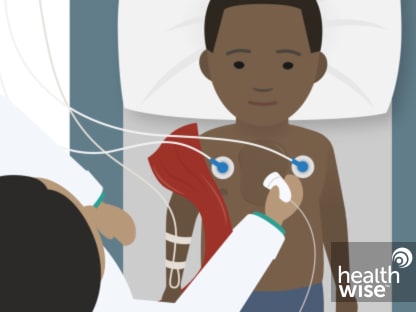Transthoracic Echocardiogram
Test Overview
An echocardiogram (also called an echo) uses sound waves to make an image of your heart. A device called a transducer sends sound waves that echo off your heart and back to the transducer. These echoes are turned into moving pictures of your heart that can be seen on a video screen.
In a transthoracic echocardiogram (TTE), the transducer is moved across your chest or belly. A TTE is the most common type of echocardiogram.
Why It Is Done
This test is done to check your heart health. It's used for many reasons. For example, it may be done to:
- Check a heart murmur.
- Look for the cause of shortness of breath or unexplained chest pain or pressure.
- Check how well your heart is pumping blood.
- Check to see how well your heart valves are working.
- Look for blood clots inside your heart.
- Measure the size and shape of the heart's chambers.
- Measure the blood pressure and speed of blood flow through the heart.
How to Prepare
You don't need to do anything to prepare. It may help to wear comfortable clothing that you can easily take off.
How It Is Done
- You may be asked to remove your clothes above your waist. You may be given a cloth or paper covering to use during the test.
- You will lie on your back or on your left side on a bed or table.
- You may receive medicine through a vein (intravenously, or I.V.). The I.V. can be used to give you a contrast material. This helps your doctor get good views of your heart.
- Small pads or patches (electrodes) will be placed on the skin of your chest to record your heart rate during the test.
- A small amount of gel will be rubbed on the side of your chest to help pick up the sound waves.
- The transducer will be pressed firmly against your chest and moved slowly back and forth. It is usually moved to different areas on your chest or belly to get specific views of your heart.
- You will be asked to do several things, such as hold very still, breathe in and out very slowly, hold your breath, or lie on your left side.
- When the test is over, the gel is wiped off and the electrodes are removed.
How long the test takes
This test usually takes 30 to 60 minutes.
Watch
How It Feels
You will not have pain from the echocardiogram. Gel is put on your chest for the ultrasound. It may feel cool. The handheld ultrasound device is pressed firmly against your chest, but it doesn't cause pain. You will not hear or feel the sound waves.
You may feel uncomfortable from lying still or from the transducer pressing on your chest. If you need to take a break, tell the person doing the test.
Most people do not feel any discomfort from ultrasound tests. But if you have severe difficulty breathing or can't lie flat for a long exam, you may not be able to have an entire echo study. Talk to your doctor or the person performing your echo about any concerns you have.
Risks
There are no known risks from having this test.
- No electricity passes through your body during the test. There is no danger of getting an electrical shock.
- You do not receive any radiation.
Results
Results are usually available within one day. If the test is done by a cardiologist, the results may be available immediately after the test.
Normal: | The heart chambers and walls of the heart are of normal size and thickness, and they move normally. |
|---|---|
Heart valves are working normally, with no leaks or narrowing. There is no sign of infection. | |
The amount of blood pumped from the left ventricle with each heartbeat (ejection fraction) is normal. | |
There is no excess fluid in the sac surrounding the heart, and the lining around the heart is not thickened. | |
There are no tumors and blood clots in the heart chambers. | |
Abnormal: | Heart chambers are too big. The walls of the heart are thicker or thinner than normal. A thin heart wall may mean poor blood flow to the heart muscle or an old heart attack. A thin, bulging area of the heart wall may indicate a bulge in the ventricle (ventricular aneurysm). The heart muscle walls do not move normally because of a decreased blood supply from narrowed coronary arteries. |
One or more heart valves do not open or close properly (are leaking) or do not look normal. Signs of infection are present. | |
The amount of blood pumped from the left ventricle with each heartbeat (ejection fraction) is lower than normal. | |
There is fluid around the heart (pericardial effusion). The lining around the heart is too thick. | |
A tumor or blood clot may be found in the heart. |
Credits
Current as of: July 31, 2024
Author: Ignite Healthwise, LLC Staff
Clinical Review Board
All Healthwise education is reviewed by a team that includes physicians, nurses, advanced practitioners, registered dieticians, and other healthcare professionals.
Current as of: July 31, 2024
Author: Ignite Healthwise, LLC Staff
Clinical Review Board
All Healthwise education is reviewed by a team that includes physicians, nurses, advanced practitioners, registered dieticians, and other healthcare professionals.


